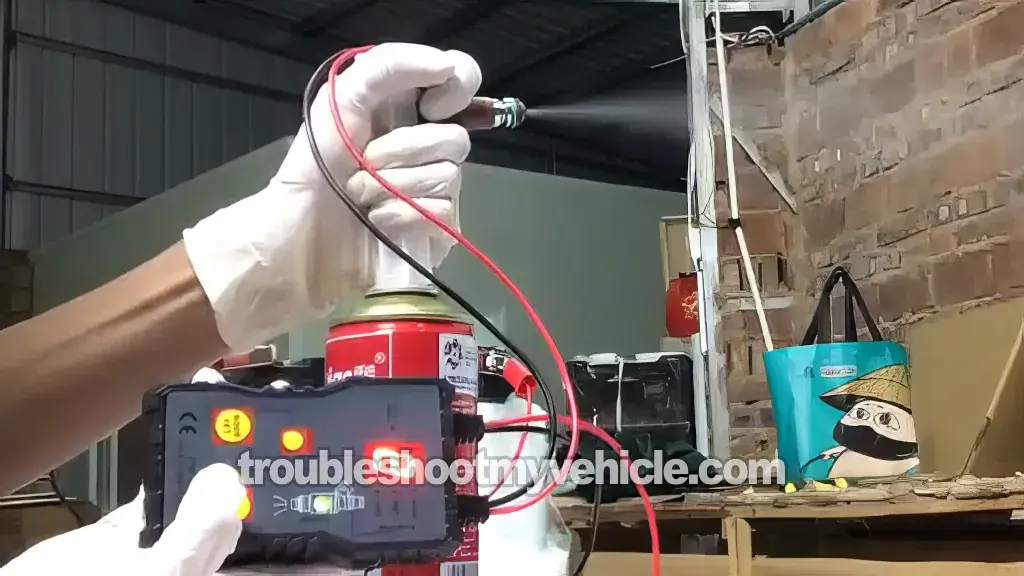
A fuel injector can pass a resistance test but may still not be delivering fuel properly or at all.
Clogged or restricted injectors are a common cause of misfires, especially on high-mileage engines.
In this tutorial, I'll show you how to test the injector spray pattern using an inexpensive tool —and how to tell if an injector is clogged or needs replacement.
This simple test can save you time, money, and frustration when troubleshooting a cylinder fuel delivery problem.
Contents of this tutorial:
APPLIES TO: This tutorial applies to the following vehicles:
- 2.0L Dodge Stratus: 1995, 1996, 1997, 1998, 1999, 2000.
- 2.0L Plymouth Breeze: 1995, 1996, 1997, 1998, 1999, 2000.
FUEL INJECTOR RESISTANCE TESTS:
CYLINDER MISFIRE DIAGNOSTICS:
Why Testing Injector Spray Matters
Just because a fuel injector passes an electrical resistance test doesn't mean it's doing its job. I've seen plenty of injectors that looked fine on a multimeter —but when I checked their spray pattern, they were barely delivering fuel... Or worse, totally clogged.
The only way to know for sure is to check the spray pattern itself. On the 2.0L engines in these Stratus and Breeze models, that means pulling the upper intake plenum to get to the injectors. There's no shortcut here —but once you know the process, it's very doable.
For this kind of test, you'll use a basic fuel injector spray and cleaning tool —one that lets you pulse the injector outside of the engine while forcing cleaner through it. That way you can actually see how well it's spraying.
The tool usually has two simple parts:
- Pulse module: This connects to your battery and pulses the injector to mimic normal operation.
- Adapter fitting: Lets you hook the injector up to a can of brake cleaner (which works great for this test) so you can observe the spray pattern.
Once everything is connected, you press the pulse button and send cleaner through the injector. What you want to see is a fine, even spray. If instead you get a weak stream, uneven spray, or nothing at all —that injector is restricted and will either need cleaning or replacement.
I can tell you from experience —this is one of the handiest tools for diagnosing misfires on these 2.0L engines. Back in the day, I would've loved to have something this simple— it really speeds up the process and takes the guesswork out of injector problems.
Where to buy it:
Disclosure: As an Amazon Associate, I earn from qualifying purchases. If my tutorials help you, using these links is an easy way to support the site at no extra cost to you. Thank you!
Checking If The Fuel Injector Sprays Fuel

Before you jump into testing, a quick word about safety: you'll be working with brake cleaner —and it's very flammable. So it's important to take a few precautions before you begin:
- Read the injector tool's instructions so you understand how it works.
- Work in a well-ventilated area —far away from heat sources, sparks, or open flames.
- Wear eye protection (trust me —I've accidentally caught brake cleaner in the face before... Safety glasses are a must).
- Wear gloves —brake cleaner is harsh on your skin.
NOTE: Before installing the same or new fuel injector, see: TECH TIP: Always Replace Injector O-Rings.
Once you're set up, here's how to do the spray test:
- 1
Remove the injector from the engine.
- 2
Remove the spray straw/nozzle from your can of brake cleaner —you won't be using it for this test.
- 3
Connect the power module's two leads to the fuel injector.
The red lead supplies power and the black lead supplies the pulse signal. - 4
Connect the injector to the test tool's adapter.
The adapter allows you to securely link the injector to the brake cleaner can. - 5
Attach the adapter to the brake cleaner can.
- 6
Pulse the injector using the power module.
This simulates the injector's normal operation and forces cleaner through so you can observe the spray pattern.
Here's how to interpret what you see:
CASE 1: The injector produces a fine, even mist. This is exactly what you want. The injector is working correctly and atomizing fuel like it should.
If the cylinder is still misfiring, the root cause is likely somewhere else —ignition, compression, or wiring. For more help, check this guide:
CASE 2: The injector doesn't spray at all. This means it's completely clogged. Replacement is the best option —fully blocked injectors rarely respond to cleaning.
CASE 3: The injector shoots a stream (like a squirt gun) instead of a mist. This means it's partially clogged. You can try running more cleaner through it to see if it clears up.
If the spray pattern improves into a mist —great. If not, it's time to replace the injector.
TECH TIP: Always Replace Injector O-Rings
One thing I really want to emphasize is —don't reuse old fuel injector O-rings. It's just not worth the risk of a fuel leak (and potential engine fire) by trying to "save time" and skip replacing them.
The O-rings seal the injector to the fuel rail —keeping fuel under pressure and preventing dangerous leaks.
Once an injector has been removed, those O-rings get so very easily get damaged —stretched or nicked— even if they look perfectly fine at first glance.
And if one fails? You could have fuel spraying into a hot engine bay —not a risk you want to take.
Here's how to do it right:
- Use brand-new O-rings that match your engine exactly —don't guess or mix and match.
- Before installing, lightly coat the new O-rings with clean engine oil —this helps them slide into place without twisting or tearing.
- Press the injector in gently and make sure the O-rings are seated properly.
O-rings are cheap —but skipping them could cost you an engine... Or much worse. It's one of those small details that really matters.
More 2.0L Dodge Stratus And Plymouth Breeze Tutorials
You can find a complete list of tutorials for the 2.0L Stratus and Breeze in this index:
Here's a sample of the tutorials you'll find in the index:
- How To Test The TPS Sensor (1995-2000 2.0L Dodge Stratus And Plymouth Breeze).
- How To Test The Engine Compression (1995-2000 2.0L Dodge Stratus and Plymouth Breeze).
- How To Test For A Broken Timing Belt (1995-2000 2.0L Dodge Stratus, Plymouth Breeze).
- How To Test The Fuel Injectors (1995-2000 2.0L Dodge Stratus, Plymouth Breeze).

If this info saved the day, buy me a beer!




